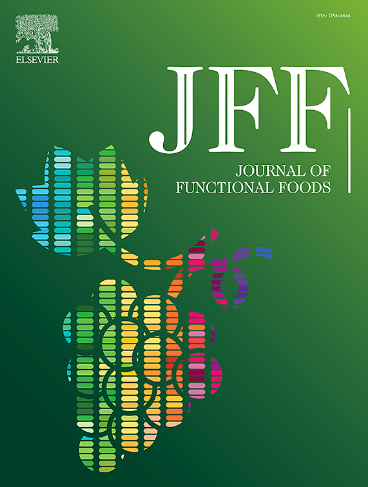黄花菊增强7,12-二甲基苯(a)蒽诱导的大鼠宫颈细胞因子调节的治疗潜力:体内和计算机研究
IF 4
2区 农林科学
Q2 FOOD SCIENCE & TECHNOLOGY
引用次数: 0
摘要
细胞因子失调在dmba诱导的具有肿瘤潜力的宫颈炎症中起核心作用。本研究采用体内和体外实验的方法研究了Gynura procumbens (GB)对关键细胞因子il -1β、IL-6、IL-10和il -18的影响。DMBA雌性大鼠分别给予100mg /kg、200mg /kg、300mg /kg的GB提取物。300 mg/kg GB显著抑制IL-1β和IL-18 (p <;0.01),同时将IL-10恢复到接近正常水平。IL-6的表达被DMBA降低,在GB处理后上调。组织学显示上皮损伤减少,再生改善。硅分析表明,与顺铂相比,GB的活性化合物,特别是非二烷酸和十四烷酸对IL-10和IL-18具有更高的结合亲和力。分子动力学模拟表明蛋白质稳定性增强,IL-18(从4.7 Å降至~ 2.7 Å)和IL-10(从6.2 Å降至~ 3.1 Å)的RMSF值降低。这些结果支持GB对具有肿瘤特征的宫颈炎症的抗炎和免疫调节潜力。本文章由计算机程序翻译,如有差异,请以英文原文为准。

Therapeutic potential of Gynura procumbens in enhancing cytokine regulation in the cervix of rats induced by 7,12-dimethylbenz(a)anthracene: In vivo and in silico investigations
Cytokine dysregulation plays a central role in DMBA-induced cervical inflammation with neoplastic potential. This study investigated the effects of Gynura procumbens (GB) on key cytokines—IL-1β, IL-6, IL-10, and IL-18—using in vivo and in silico approaches. Female rats treated with DMBA received GB extract at 100, 200, or 300 mg/kg weight. GB at 300 mg/kg significantly suppressed IL-1β and IL-18 (p < 0.01) while restoring IL-10 to near-normal levels. IL-6 expression, reduced by DMBA, was upregulated following GB treatment. Histology revealed reduced epithelial damage and improved regeneration. In silico analysis showed that GB's active compounds, particularly nonanedioic and tetradecanoic acids, had higher binding affinity to IL-10 and IL-18 than cisplatin. Molecular dynamics simulations indicated enhanced protein stability, with RMSF values reduced in IL-18 (from 4.7 Å to ∼2.7 Å) and IL-10 (from 6.2 Å to ∼3.1 Å). These results support the anti-inflammatory and immunomodulatory potential of GB for cervical inflammation with neoplastic features.
求助全文
通过发布文献求助,成功后即可免费获取论文全文。
去求助
来源期刊

Journal of Functional Foods
FOOD SCIENCE & TECHNOLOGY-
CiteScore
9.60
自引率
1.80%
发文量
428
审稿时长
76 days
期刊介绍:
Journal of Functional Foods continues with the same aims and scope, editorial team, submission system and rigorous peer review. We give authors the possibility to publish their top-quality papers in a well-established leading journal in the food and nutrition fields. The Journal will keep its rigorous criteria to screen high impact research addressing relevant scientific topics and performed by sound methodologies.
The Journal of Functional Foods aims to bring together the results of fundamental and applied research into healthy foods and biologically active food ingredients.
The Journal is centered in the specific area at the boundaries among food technology, nutrition and health welcoming papers having a good interdisciplinary approach. The Journal will cover the fields of plant bioactives; dietary fibre, probiotics; functional lipids; bioactive peptides; vitamins, minerals and botanicals and other dietary supplements. Nutritional and technological aspects related to the development of functional foods and beverages are of core interest to the journal. Experimental works dealing with food digestion, bioavailability of food bioactives and on the mechanisms by which foods and their components are able to modulate physiological parameters connected with disease prevention are of particular interest as well as those dealing with personalized nutrition and nutritional needs in pathological subjects.
 求助内容:
求助内容: 应助结果提醒方式:
应助结果提醒方式:


